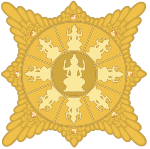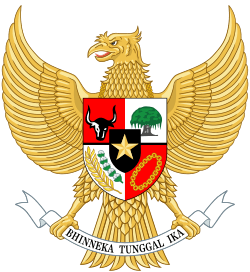Kingdom of Bolaang Mongondow
The Kingdom of Bolaang Mongondow, previously known as Kingdom of Bola'ang, was a state that ruled over majority of area of the present-day Bola'ang-Mongondow regencies in the North Celebes province of Indonesia, excluding Bola'ang Mongondow Utara regency, which was a territory that was ruled by smaller kingdoms of Bintauna and Kaidipang.
Kadatu in Bola'ang-Mongondow Kingdom of Bola'ang-Mongondow | |||||||||
|---|---|---|---|---|---|---|---|---|---|
| 1670–1950 | |||||||||
| Status | independent kingdom (1670–1901), part of Dutch East Indies (1901–1942), part of Empire of Japan (1942–1945), part of Republic of Indonesia (1945–1950) | ||||||||
| Capital | Bola'ang (1670) Kotobangon (1893) | ||||||||
| Common languages | Mongondow (official), Manado Malay, Lolak, Ponosakan, Bantik, Tonsawang, Tontemboan, and Bentenan | ||||||||
| Religion | Sunni Islam, Animism, Catholicism, Calvinism | ||||||||
| Government | Monarchy | ||||||||
| Datu | |||||||||
• 1670-1694 | Datu Loloda Mokoagow | ||||||||
• 1694-1730 | Datu Yakobus Manoppo | ||||||||
• 1735-1764 | Datu Salomon Manoppo | ||||||||
• 1893-1901 | Datu Riedel Manuel Manoppo | ||||||||
• 1901-1928 | Datu Kornelius Manoppo II | ||||||||
• 1928-1938 | Datu Laurens Kornelius Manoppo | ||||||||
• 1938–1950 | Datu Henny Yusuf Kornelius Manoppo | ||||||||
| History | |||||||||
• Ascension of Datu Loloda Mokoagow | 1670 | ||||||||
• Dissolution of kingdom | 1950 | ||||||||
| Currency | Doit used in the shore settlements, in the inlands the barter system was used | ||||||||
| |||||||||
| Today part of | |||||||||
The kingdom was founded in 1670 AD by a Mongondow prince Datu Loloda Mokoagow (died 1695). He was the son of the paramount chief of Mongondow, Tadohe (1600–1670), seated in Kotobangon in the heartland of Mongondow plateau, while the prince established himself at the port settlement of Bola'ang and went to conquer many of the northern shores and inland settlements of present-day Minahasa regencies of northern Celebes peninsula. When he succeeded his father in 1670, he titled himself datu (king) instead of the traditional Mongondow title of punu (paramount chief). This marked the beginning of Kingdom of Bola'ang.
At its peak, the kingdom covered Bola'ang (present-day Bola'ang village), Mongondow plateau (present-day Kotamobagu city and its vicinity), Kotabunan (present-day Kotabunan of Bola'ang Mongondow Timur regency), Mandolang port (present-day Belang of Minahasa Tenggara regency), the banks of Ranoyapo river including Tumpa'an, Tareran, Tanawangko, and Tateli (present-day Minahasa Selatan regency),[1] Umuda (present-day Amurang city), Manarow (present-day Manado-Tua island), and Wenang (present-day Manado city).
However, on September 21, 1694, a contractual agreement to establish new territorial borders was signed between the Kingdom of Bola'ang and the newly unified federation of Minahasan tribes, backed by the Dutch.[2] The borders were established along Poigar river as the northern border and along Buyat river as its southerly counterpart. The border thus divided the westside territory for Bola'ang and the eastside territory for Minahasan people, which made the kingdom of Bola'ang lose all of its territories and subjects on the east side of the borders. Thus, it left only Mongondow plateau and the adjacent Kotabunan as the territory of the Bola'ang, hence the name Kingdom of Bola'ang-Mongondow was used thereafter.
Etymology
The name "Bola'ang" came from the name of the settlement where the Datus ruled the realm from. Bola'ang alternatively spelled Gola'ang is an Old-Mongondow word meaning "enlightened due to a glimpse of sunlight pierce through the canopy of dense forest". "Mongondow" came from the name used to refer to the various groups of people living in the plateau of the same name. The people of the plateau got their name from their custom of momondow, which is "shouting signal words to communicate to peers in the jungle, or shouting a victorious battlecry".[3]
History
Pre-establishment
Early of 15th century, the Mongondow people, mainly lived in the Mongondow plateau northern Celebes peninsula interior, had long were ruled by a succession of paramount chiefs titled Punuˀ.
Conquest
Establishment of Bolaang-Minahasa border
Islamization
Dutch rule
Japanese rule
Annexation to Republic of Indonesia
Government and economy
Administration hierarchies
Since Punuˀ Tadohe (1600)
Punu' --> Sadaha --> Kimalaha/Sangadi/Bobato
The first king, only change the term Punuˀ to Datu, while the rest are the same.
Since Datu Yakobus Manuel Manoppo (1833)
Datu --> Jogugu --> 3 Presiden Raja & 3 Kapita Laut --> Kimalaha/Sangadi/Bobato
Since Datu Kornelis Manoppo II (1901)
As Dutch Landschaps:
Datu --> Jogugu --> Presiden Raja & Kapita Laut --> Panggulu—Mayor Kadato --> Sangadi—Porobis
Economy
Agriculture
Swidden farm & paddy plantation
Coastal-interior trade
Gold-mining
Culture and society
Social class system
Paloko-Kinalang
The most basic class system of Mongondow society formed at the time of chief Damopoli'i (1480). It consist of two classes, bounded by the most sacred vows (odi-odi):[4]
Rulers (Kinalang)
Class of chiefs and their relatives. They had the right of absolute obedience from the commoners, while they are required to improve all aspects of the commoners' welfare.
Commoners (Paloko)
The commoners were required to give absolute obedience to the ruling class (even required to mourn for their death for days), while they had the right that their welfare be improved.
Six class system
The social class system was reformulated by chief Tadohe at the beginning of his reign.
Elites
First Class: Mododatu (king's closest relatives, the males might be chosen as heir to the throne)
Second Class: Kohongian (king's relatives, but the males might not be chosen as heir to the throne)
Commoners
Third Class: Simpal (bureaucrats, administrators)
Fourth Class: Nonow (common people, workers and farmers)
Slaves
Fifth Class: Tahig (guards, errands)
Sixth Class: Yobuat (lowest slaves)
Language
Technologies
Arts
Religions
Islam
Animism
Native rituals
Collective ritual (sibi)
Personal rituals
Bird cry hearing
Christian
Gallery
See also
Notes
References
- "Website Resmi Pemerintah Kota Manado". Manadokota.go.id. Archived from the original on 2015-06-27. Retrieved 2015-06-26.
- Dunnebier, W. (1958), Over de Vorsten van Bolaang Mongondow
- https://web.archive.org/web/20150621165948/http://www.bolmong.go.id/. Archived from the original on June 21, 2015. Retrieved June 20, 2015. Missing or empty
|title=(help) - "Kerajaan Bolaang Mongondow". Melayuonline.com. Retrieved 2015-06-26.


